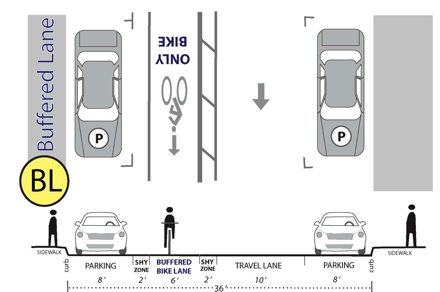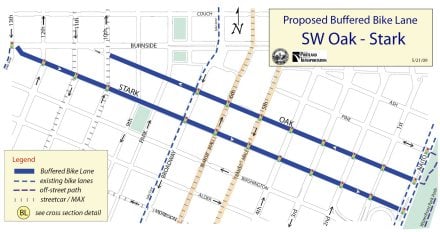
Today the City of Portland Bureau of Transportation will announce plans for their “buffered bike lane” project (which they are also calling an “enhanced bike lane”). The new bike lane design will be implemented on SW Oak and SW Stark streets from Burnside (at 13th and 10th respectively) to Naito Parkway.
“The City wants Portlanders to be comfortable coming to downtown on a bicycle – whatever their skill level – and I want Portland to be the most bike friendly and sustainable City in the nation.”
— Mayor Sam Adams
The design is similar to the new cycle track that’s coming to Broadway, with the major difference being its location relative to parked cars. Like with the cycle track, PBOT will re-purpose an existing motor vehicle lane in order to create a wide, bike-only lane. But unlike the cycle track — where parked cars are to the left of bike riders and act as a physical barrier to auto traffic — the parked cars in the buffered bike lane design will be in their more standard, curbside location. (For more on the cycle track, check out PBOT’s website.)
Once complete, people on bicycles riding on Stark and Oak will enjoy 10 feet of biking space all to themselves. The plans call for a six-foot wide bike lane with an additional two-feet of “shy zone” on either side (hence the term “buffered”). Mayor Adams says the goal for the new design is “to make cycling more comfortable and provide an inviting pedestrian friendly retail environment.”

In a statement released with the plans, Mayor Adams said he has directed PBOT to implement this new bike lane design along with the cycle track as one of two “innovative infrastructure projects to help take cycling in Portland to the next level and encourage more people to make sustainable choices.”
Adams’ plan is to evaluate the projects side-by-side to see which of the two work better.
Also in a statement, Adams acknowledged that these streets currently work well for people who are comfortable riding in traffic, but they’ve decided to try these two projects because, “most Portlanders tell us that they would use a bicycle much more often than they currently do if they had these kinds of options.” He also added that:
“The City wants Portlanders to be comfortable coming to downtown on a bicycle – whatever their skill level – and I want Portland to be the most bike friendly and sustainable City in the nation.”
City Traffic Engineer Rob Burchfield said there are still a few design kinks to work out. SW Oak St. is currently two-way between Naito and 2nd (making the enhanced bike lane design impossible), so PBOT is looking into returning that section back to one-way operation.
I asked Burchfield about right-turn movements over the new bike lanes. He said at intersections with heavy right-turn activity — like on Stark at Broadway and 3rd — they will look to create (by removing parking) a right-turn lane for autos to separate right-turning motor vehicles from through bike traffic.
Like with the Broadway cycle track, PBOT chose Stark and Oak in part because they have relatively low traffic volumes and they found through modeling that the removal of one motor vehicle lane would not inhibit existing traffic flow.
Burchfield estimates the cost of each enhanced lane to be about $45,000 (similar in cost to the cycle track). PBOT hopes to have the new lanes installed in August of this year.
For more information, check out PBOT’s enhanced bike lane FAQ (also learn more on their website):
What is an enhanced bicycle lane?
An enhanced bicycle lane is designed so that it provides a more protected and comfortable space for cyclists than a conventional bike lane and does not have the same barriers to sight lines as a Cycle Track – where view of cyclists may be obstructed by parked cars.
Why are we constructing enhanced bicycle lanes (i.e., what’s wrong with these streets the way they are now)?
These streets currently work fine for people who are comfortable riding bicycles in mixed traffic. However, our designs are intended to make bicycling more comfortable for the majority of Portlanders who are not comfortable riding under such conditions. Our analysis indicates that most Portlanders would use a bicycle much more often than they currently do if they didn’t have to mix so much with automobiles. A buffered bicycle lane provides that opportunity.
Why not use a simple bicycle lane?
Because the enhanced bicycle lane, with the added shy zones, offers a more comfortable riding environment that we believe it is more consistent with our efforts to make bicycling a part of daily life in Portland.
How does an enhanced bike lane provide more protection for cyclists than a bike lane?
Enhanced bike lanes provide more protection for cyclists by providing ‘shy’ or buffered zones on either side of the cyclist.
What will drivers notice that is different about driving on a street with an enhanced bike lane?
There isn’t much of a change for drivers. They will still need to watch carefully for cyclists when they are turning right at cross-streets or driveways. They will also need to take care when parking on-street which is accomplished by crossing the enhanced bicycle lane. Cyclists will always be clearly visible to drivers because, unlike a Cycle Track, the buffered bicycle lane does not have the barrier of parked cars between the bicycle lane and the travel lane.
The travel way for vehicles will also be narrower. On SW Stark and SW Oak, the number of travel lanes will be reduced from two to one.
Will SW Stark and Oak Streets become congested if there is only one travel lane for vehicles?
Our traffic analysis indicates that these streets will operate with little additional delay for cars when reduced to one travel lane. One of the reasons that these streets were selected for this demonstration project is because they have light traffic flows and extra street capacity available for other users.
How does parking work adjacent to an enhanced Bicycle Lane?
Drivers park parallel to the buffered bicycle lane in the same way that they do today except that they will need to yield to bicycles before crossing the enhanced bicycle lane to reach the parking lane. The parking lane is adjacent to the curb.
Are buffered bicycle lanes expensive to implement?
The Enhanced Bicycle Lane proposed for this demonstration project eliminates a travel lane so no construction is needed. As a consequence, they are low cost and relatively easy to implement.
Do Enhanced Bicycle Lanes provide any benefit for retail businesses on the street?
The reduction of one travel lane can provide a calmer environment for retail businesses without reducing area parking. Additionally, this improvement will attract more cyclists to the street and more people will use the street in total. This will likely be a benefit to businesses that attract passer-by shoppers.

